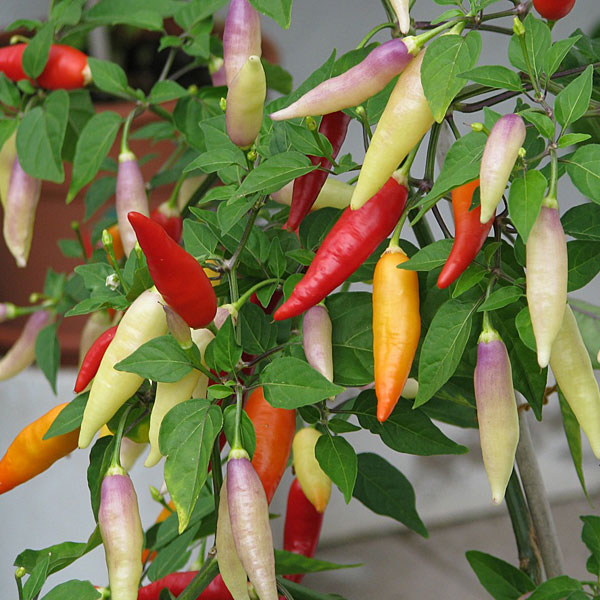 Loading... Please wait...
Loading... Please wait...
Blog - chilli growing guide
Is it time to grow chillies yet? Heaven Yes!
Posted by Brighton Chilli Shop on 14th Jan 2016
It's that time of the year again and we need to get cracking on planting our beloved chillies.
As you have probably noticed in the shop and online aready, we at Brighton Chilli Shop have an extensive range of chilli seeds starting from world's hottest chilli Carolina Reaper, Moruga Scorpion, Naga/Ghost/BhutJolokia, Habanero, Scotch Bonnet, Pimento de Padron, Peter Pepper Red, Numex Twilight and many many more.
In addition to the chilli seeds becauce of demand we have now brought in stock seeds of Tomatillo Verde (Physalis ixocapra), Tomatillo Purple (Physalis ixocapra), Tomatillo Pineaple (Physalis ixocapra).
For those who haven't done this before bellow is a simple guide to growing chillies:

| Growing your own chillies is easy and enjoyable!
What Do I need? 1. Chilli seeds Guidelines |
The following is intended only as a general indication. Because of the difference in soil, climate and other environmental conditions these instructions may need to be modified. For best results it is advised to sow chilli seeds in spring or even earlier. In the UK for instance, the best time would be from January to April. Like tomatoes, chilli plants are warm season crops.
| To
start, place potting soil in the tray or pot and cover ¾ of the depth.
Then place the seeds on the top with sufficient space between each seed
and then cover it with 0.5 cm of potting soil. Then spray water over
them but if this exposes the seends. Cover them with a bit more soil but
be careful. Putting the seed too deep into the soil may result in the
seeds not germinating at all.
The ideal temperature for chilli seeds to germinate is between 24-30 degrees Celsius (76-86 degrees Fahrenheit). If the temperature is lower than that, the seeds will remain dormant. In order to accelerate the germination process, some growers soak the chilli seeds for a couple of hours before placing them in the soil. It’s best to use a seed tray with a lid as this creates an optimally humid environment for the chilli seeds. If you opt to cover them with cellophane, please do not forget to poke a few holes in it in order to promote oxygen circulation. Label the chilli seeds [AB1] so that they don’t get mixed up during the process. Afterwards, place the pots or seed tray in a warm spot. This could mean a sunny place, a heated space or by a radiator to make certain that germination is successful. If you wanted to be really professional, you could use a heated propagator. At this point all the seeds need is warmth, moisture and oxygen. Ensure the soil is kept moist but not wet, or else the seeds may rot. Keep fungi at bay by ventilating the system at times. Fungi are capable of killing seeds and seedlings. After germination has occurred, (a time span varying from 5 to 14 days depending on variety), the seedlings need more light as well as heat, moisture and oxygen. Chillies love plenty of light. If there’s inadequate light in your house, a light for growing plants will be necessary. Re-potting usually should be done when the plant looks strong enough to handle it. The golden rule is to re-pot it when the seedling has grown a second set of leaves. Remove the plant carefully without damaging the roots and place it into a bigger pot with compost or soil. Repeat the process again when the roots try to escape via the drainage holes. When the weather permits and the plant is strong enough, you can put your plants in the garden (April in southern Europe and around May in northern Europe). Be careful, however! Expose the plants gradually to the outside, starting with a few hours initially then later take them inside again. Repeat the process by extending the outside time until eventually they stay out permanently for the summer. Gradually expose them to the sun to avoid sunburn. If needed, support them with bamboo sticks. When the cold days come back put the plants back in a warm place at night until eventually they’re permanently back indoors. The first flowers will indicate the first sign of a chilli fruit. If you live in northern Europe, it is a good idea to feed the plants with chilli focus which will maximise the fruit production. Tomato focus will also do, but it is not as good as chilli focus for chilli plants. After pollination occurs, a process caused by the wind, bees and other insects or you and your cotton bud, the flowers will drop and peppers will grow instead. The chillies will then grow and you should expect to harvest approximately 80 – 90 days after you planted them. Chillies can be eaten while still green, but they’re at their best when they change colour. You can then freeze, dry or pickle your chillies for the winter to come. |
We hope you enjoy the process as much as we do and that is a lot. If you want to know more about growing, follow the chilli man on this link: linkhttp://www.thechileman.org/guide_home.php
